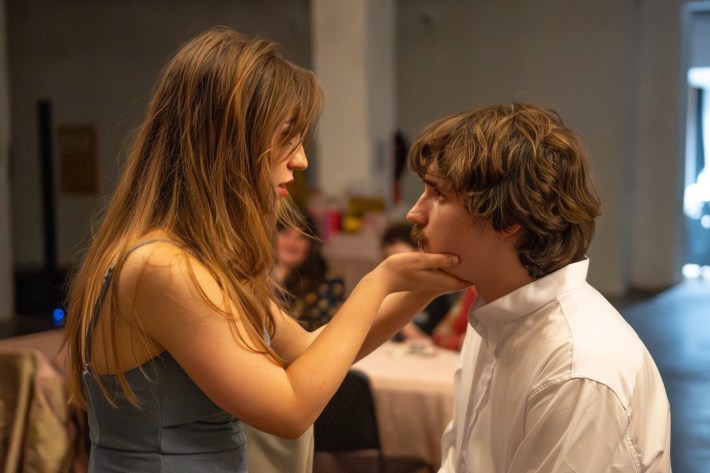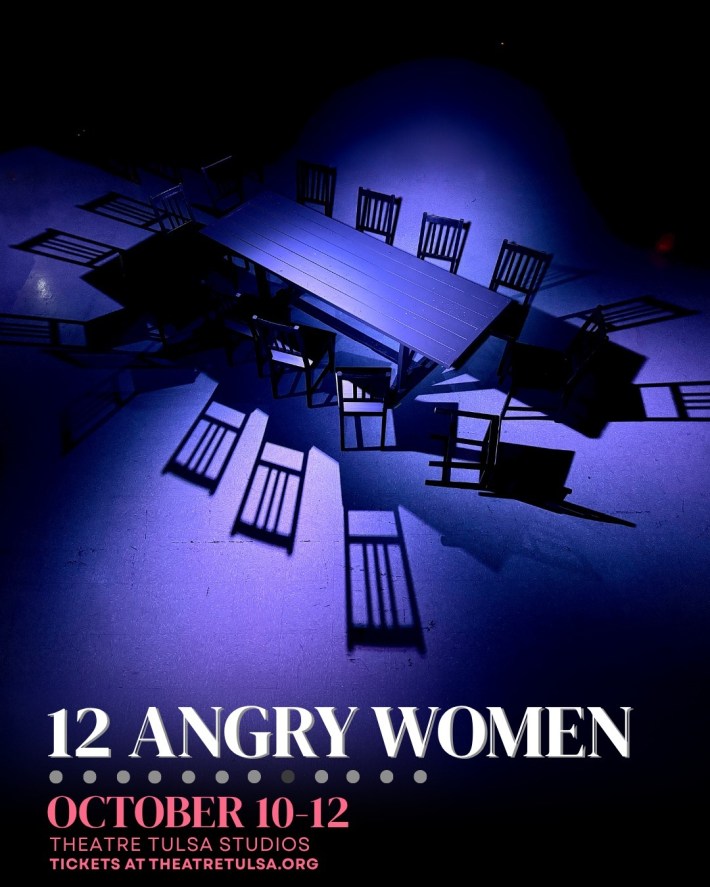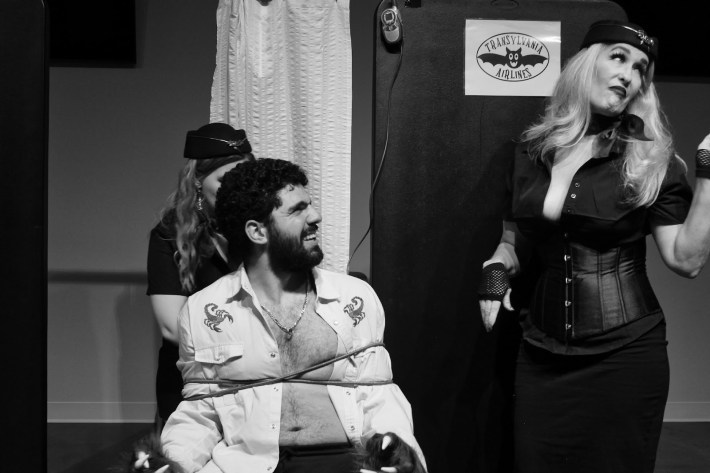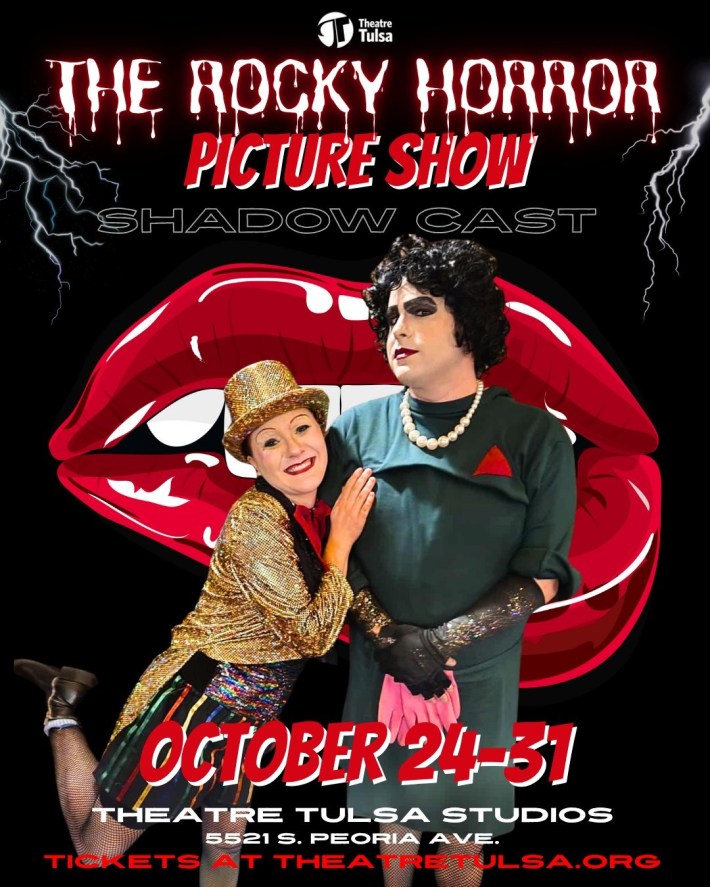This fall, Tulsa’s busy community theatre companies have been running the genre gamut, packing local venues with everything from drama to horror to original adaptations. For all that range, several of them have had one thing in common: they were staged in nontraditional spaces as “immersive” productions.
Immersive theatre is a trend that’s taken off locally in the past year, though it’s been a thing in the performing arts world far longer than that. The most well-known example of immersive theatre, and the one that kickstarted this 21st century trend, is Sleep No More, a New York City troupe’s adaptation of Macbeth in which the audience followed actors around a multi-floor hotel to experience the story, told mostly through movement and action. Since then, several immersive productions have been making their way around the New York City circuit, like Cabaret at the Kit Kat Klub, a recently closed revival that staged the musical in the round in a club, and Cats: The Jellicle Ball, a revival of Andrew Lloyd Webber’s musical reimagined in NYC’s ballroom scene. This kind of theatre is designed as an experience for the audience, not just something to observe, and audiences are responding: Sleep No More, incredibly, ran for nearly 14 years.
Here in Tulsa, a surge of new theatre companies, led by some of the city’s younger and newer creative talents, has brought immersive theatre fully into the city’s performing arts mix. Some of the drive is practical: for one thing, newer companies don’t have the budgets of legacy companies when it comes to sets and space rentals (a lack now exacerbated by diminished grant funding for the arts). But there’s also a creative vision involved: an urge to create a unique, innovative, elevated art experience that might appeal to people who aren’t typically into theatre.
What is immersive theatre, anyway?
Generally speaking, when you see the word “immersive” in marketing for a show, you can expect some sort of blurring of the boundary between performance and reality, where the audience is somehow part of the piece. Immersive shows often happen in nontraditional or “found” spaces, sometimes forgoing a stage altogether and placing the actors and the audience together in the same location, not separated by a traditional theater’s boundary line between stage and seats.
While “immersive” can mean “participatory,” the audience does not necessarily need to participate with the actors for a production to be immersive. Whether an immersive show is interactive or not, the role the audience plays, whether literal or theoretical, helps construct the overall meaning of the piece.
So what does immersive theatre look like right now in Tulsa? Is it working? Is it cool? I went to four such shows in the past month, and here’s what I saw.
Riffraff Tulsa: Rope
Living Arts of Tulsa
September 25, 2025

Riffraff Tulsa’s season opener was, on paper, a textbook example of immersive theatre. Director Meagan Mulgrew brought her original adaptation of Patrick Hamilton’s 1929 play, Rope, to the galleries of Living Arts, where viewers were “immersed” in the world of the production as soon as they walked in the door. Surrounded by pink and gold streamers and balloons, we received a program designed to look like a party invitation and were encouraged to grab a drink at the bar before finding a spot at one of six pink-tableclothed tables arranged in a rectangle in the center of the gallery. Since there were seats on both sides of the table, I asked if the audience could sit wherever. Only in the seats that face inside the rectangle, I was told.
After scoping out a spot, I passed a giant pile of presents stacked neatly on a table near the bar. While ordering my drink, I noticed one of the actors in the prep kitchen behind the curtain, making what looked to be a charcuterie board. Had the play already started? Or was he just helping set up his prop? I wasn’t sure if I could ask, so I grabbed my drink and headed to my seat, eager for more easter eggs, feeling a pleasurable tension build thanks to the uncertainty about what was part of the performance and what was just people hanging out.
Rope follows college students Brianna (Hannah Gray) and Charlie (Nicholas Mueller), who murder their classmate Eva (Prudence Lloyd) in the first few minutes of the play and then host a birthday party for her, to which they’ve invited Eva’s friends, exes and family. One guest is the duo’s former professor, Rupert (Quinn Blakely), who knows something is amiss when Eva doesn’t show up to her own birthday party, then spends the rest of the play prodding.
As the welcome music faded out, Lloyd entered the rectangle and began to address the group as Eva, thanking us for coming to her birthday party (and noting the locations of the exits) in a rather creative curtain speech. Suddenly, Gray emerged from a corner, eyes stone cold, followed by Mueller from the other side of the room. The lights went out and in two blinks, Eva was dead, strangled by a piece of rope.
The rest of the play was staged in real time, as if the murder had truly just happened in front of us. Actors came and went from elsewhere in the gallery into the “party” space with the viewers; the party’s hired help, Sabot (Tine Beyaert), bopped to and from the bar as she fetched drinks, the charcuterie platter, even a broom and dustpan to clean up a broken bottle. Whenever two actors had a private scene together, it happened in front of the viewers, as the rest of the ensemble orbited around the periphery admiring the actual art show (Austin Gober’s Dinkum Hokum) hanging on the walls or chasing each other in flirty cat-and-mouse pursuit.
But once the audience entered and sat down as guests at this party, it felt like their “role” in the piece was largely over. We were able to get up to go to the bar or the restroom, or to snoop on actors who might have been doing something in another part of the gallery, but since all the main action was happening in the rectangular playing space, I never felt compelled to go explore. Occasionally, actors sat on the interior side of the tables, across from an audience member, but they never addressed or acknowledged us, the established other “party goers.”
The staging essentially became a play “in the round” after the first few minutes. We were immersed in the world of the play, yes, but in what sense were we part of it? I pondered the passive role of the audience for a few days after seeing the show. It made me wonder if Riffraff was intentionally forcing us into complacency to prompt self-examinations of our own morality. Would we ever cheer for a known murderer? Were we, in fact, complicit? In the heat of the climax, when it was clear that Rupert had almost caught the kids, I found myself rooting for Brianna and Charlie to get away with it. This shocked me. Was I supposed to feel this?
And what did I really know about Eva, anyway? She appeared briefly for the curtain speech, but during the party itself we only heard little facts about her—enough to paint a picture, but not quite enough to make her sympathetic. Because so many of the characters had complicated relationships with Eva, I didn’t really feel for her until her father, Mr. Kently (played by Andrew Smith), broke his austere demeanor briefly, his concern for Eva leaking in a moment of vulnerability. But the moment fluttered away as quickly as it came, and I found myself arrested with the characters right in front of me, who I had watched for the past 75 minutes. Were we Eva’s friends? Was everyone in the show as complacent as the audience, at the end of the day? It made me wonder if this was the role Mulgrew intended the audience to play.
With its immersive staging, Rope tried to emulate the reality of an art-gallery party gone wrong—an effort that worked on some levels, particularly in the choices of the actors, who were empowered to create characters on stage, not caricatures. As Eva’s ex, Leila, Kara Mitchell was effortlessly hilarious, saying her lines with such casual confidence that their humor sneaked up on me. I might have expected a cathartic, maniacal moment from Gray at the end, after watching her keep it rather cool and collected, staying one step ahead of everyone else throughout the party; she made a different choice, leaving me face to face with the sickening notion of how empty Brianna is, which is almost as haunting. Blakely enlivened the final moments as Rupert cornered the duo, and his back-and-forth with Gray was compelling. Mueller’s hyperrealistic 90-minute slow burn panic attack was both nauseating and astonishing.
These performances, like the party setup itself, were interesting on their own, but as a whole Rope lacked a feeling of urgency, which a more clearly-defined vision for the role of the audience might have supplied.
Eclipse Theatre Collective: 12 Angry Women
Theatre Tulsa Studios
October 10, 2025

Eclipse Theatre Collective is a relatively new company in town, led by Chris Porcelli and Allison Johnston, who makes her directorial debut with this production. 12 Angry Women, an adaptation of the Emmy-award winning television movie by Reginald Rose, follows 12 women who are serving on the jury for a 19-year-old boy’s murder trial. It opens with almost all of the characters convinced that the boy is guilty; Juror 8 is not convinced by the prosecution’s arguments and helps the jury look at the case from new angles.
While not explicitly an immersive production, 12 Angry Women had immersive qualities that worked in its favor. In Theatre Tulsa’s black box space, Johnston chose to stage the play in the round, with harsh white lighting by Porcelli and an effectively drab set that brought the audience into a space that felt as hollow as the city-owned public service building it emulated. It was also eerily silent—no pre-show music, just that vacant feeling you get in a real-life jury room.
Johnston guided the actors well through the beats of the piece, and strong acting choices made personalities pop on stage. While the larger story flowed well, and it was a treat watching those personalities clash and meld, I didn’t always buy it when certain characters decided to change their minds, whether about the vote or another character in the room. You could attribute this to the script itself (it’s hard to detail the arc of 12 individual characters in under 90 minutes) but a part of me wonders if I missed those story beats because I struggled to see the faces of half the cast at any given moment. For most of the production, they sat close together on two sides of a narrow table, which meant I saw mostly the back of half a dozen actors’ heads.
Johnston did find moments throughout the play to get the actors out of their seats—walking to the water cooler or window, throwing away trash, having an aside in the corner of the stage—all practical and realistic movements that broke up the debate. One directorial decision broke the hyperrealistic presentation. At two key moments in the play, the lights went to black, the cast picked up their props, and they rotated 180 degrees so that by the time the lights went up again, they were in a mirrored position. But after they rotated the first time, the actor sitting at the head of the table directly in front of me stood up, blocking my view of the faces I was finally seeing for the first time. It didn’t last long, but I did feel jilted in the moment.
Thematically, the decision to rotate the cast allowed the audience to theoretically “see all sides” of the case: an interesting, immersive element to add. But if the direction already breaks reality with blocking choices like rotating the actors 180 degrees in a flash of darkness, why not add other non-realistic elements, even something as simple as a wider table to space the actors out more? A little more imagination—and consideration of the audience’s experience—could’ve catapulted this play from a good drama into something astonishing.
Heller Theatre Company: Hellerween
101 Archer
October 15, 2025

Heller Theatre Company’s annual showcase of horror- and suspense-themed short plays is consistently a fun experiment in immersive theatre. The production takes over the floors of The University of Tulsa’s 101 Archer building, adorned with Halloween and haunted house decor; tour guides, who this year were “in character,” lead the audience through the building to see a different short play in each space. I attended an invited dress rehearsal, so I didn’t experience the full effect (and missed one of the plays). But in the plays I did see, the immersive elements are what made the experience for me.
Alone in the Station (written by Levi Gerber, directed by Jeremy Garrett) incorporated a thunderstorm soundscape that, combined with the isolated light which kept the audience in the dark and shined a stark bright glare on the actors, did a good job setting the mood for the piece. Cotard’s Syndrome (written by H.V. Patterson, directed by Melissa Johnson) dropped me into its eerie world immediately as I walked into the room past Dr. David Martin (played by Everett LeViness), typing away on a desktop computer in a way that anyone who has been to a doctor's appointment can recognize. Once the play officially started, I could see the character Leila (played by Ashe Baileigh) lurking through a window, staring into space ominously before making her entrance. The feeling of being stuck in a room, with all of these events happening around you, amplified the suspense and created a tone perfect for a Halloween showcase.
The play that took immersion furthest was the least scary one of the night. Alliumphobia (written by Dan Hitzman, directed by Andrew Smith) followed two vampire flight attendants and a werewolf who started to transform mid-flight. It was a meandering comedy, filled with light gags and puns, but the immersive elements amplified it into one of my favorites of this year’s Hellerween.
Hitzman, dressed like a werewolf in a police uniform, scanned audience members as they entered, looking for stakes, garlic, and other items that magical creatures can’t be around. When we took our seats, we found a sheet of paper detailing all the rules of the airline. The minimal set effectively mimicked the inside of a plane: seats arranged in two rows, two curtains upstage that called to mind a clear separation between first class and coach. Kristen Kogerman and Emily Peterson leaned fully into their roles as vampire flight attendants, addressing the audience as if they were the passengers throughout the piece. The werewolf, played by Daniel Ghoziel, started at the back of the audience and exuberantly performed in his seat, in the aisle, and up at the front with the vampires, truly wrapping the audience into the piece.
While actor/audience interaction was kept to a minimum at Hellerween, viewers got thrown into the night’s suspense, fear, and fun through the event’s immersive staging.
Theatre Tulsa/Eclipse Theatre Collective: The Rocky Horror Picture Show Shadow Cast
Theatre Tulsa Studios
October 24, 2025

Even if you haven’t been before, you’re probably aware of the Halloween tradition that is attending public screenings of the 1975 film The Rocky Horror Picture Show, where audience members talk back at the film and throw objects at the screen. Theatre Tulsa has partnered with Eclipse Theatre Collective the past three years to put on their own version of the event, taking the experience a step further with a shadow cast of actors who “perform” the action of the movie in front of the screen while lip synching to the songs and dialogue.
This production found some silly and creative ways to “act out” the movie. Kara Young-Paden zipped around the audience on a scooter while “singing” Eddie’s song “Hot Patootie, Bless My Soul.” Aubree Harper slayed as The Lips, cleverly shining her phone flashlight on her face to mimic the moments the lips appeared on the screen as she exaggerated the lyrics to the opening song. The actors got in on the silliness with some of the movement requirements, specifically when they had to “swim” on stage during “Don’t Dream It,” which just made the moment funnier. The way lighting designer Chris Porcelli (who also played Dr. Frank-N-Furter) perfectly timed the lights to flash, pulse, and strobe with the movie made me feel completely sucked into every moment.
The overall effect was a bit overstimulating at times. While we had a sheet telling us the call-and responses, it was typed out so small and the room was so dark that I couldn’t read it. My attention kept darting between the IRL actors and the movie as my brain pieced together the proceedings. But that’s part of the fun. It’s already a bit of a nonsense film; why not make it more nonsensical? Pretty early on I decided to turn my brain off and just vibe.
Out of all the theatre I saw this month, this show had the most active audience. I went to the 7pm showing on opening night, which had a lot of older audience members and teenagers. I went in anticipating it would be tamer than the 11pm group later that evening, but everyone clearly came out to have a good time. Several people arrived in costume. Four brave Rocky Horror newbies took on the “virgin ritual” (which I will not spoil). Theatre Tulsa provided prop bags, but some folks came with their own; a few groups didn’t need the call-and-response sheet at all and had additional responses that I’d never heard before; about half of the attendees stood up to do the Time Warp.
While the cast (and obviously the movie) didn’t really address the audience, the audience’s presence forced a participatory conversation, ultimately rewriting the film and making it an entirely different experience than you’d have watching it at home or even as a standalone movie in a cinema.
So where does Tulsa's immersive theatre go from here?
As I’ve taken this tour of immersive theatre experiences over the past month, a moment from the 2008 film Synecdoche, New York has kept coming to mind. Its protagonist Caden Cotard (played by Philip Seymour Hoffman) is a director who spends decades trying to replicate reality in his theatrical work, constantly refining and reworking to make things feel true. But out of everything he’s created, it’s the least “realistic” moment in his project—a funeral monologue that includes someone else playing him—that ends up holding the strongest resonance and ringing most true to him.
This is how I feel about immersive theatre. Replicating reality isn’t the point. In shows like this, directors can create truer meaning, and a more engaging piece, by taking more artistic liberties.
For further reading
“A History of Immersive Theatre on Broadway” by Diep Tran, Playbill. Feb. 21, 2024.
“What is Immersive Theatre?” by Suzy Woltmann, Backstage. May 8, 2023.
“What is Immersive Theatre?”, Punchdrunk Entertainment. June 19, 2024.






